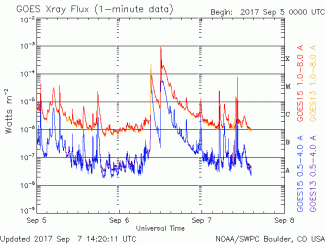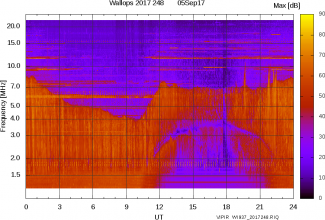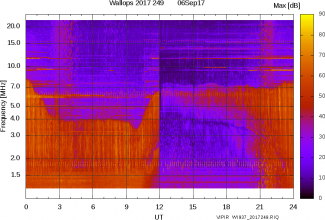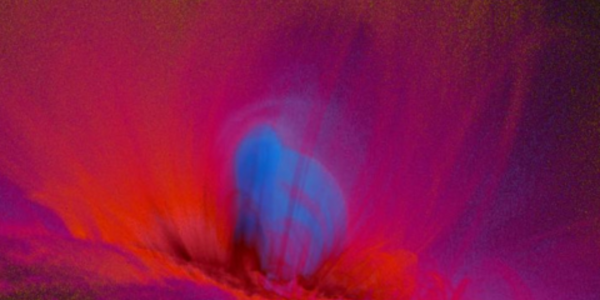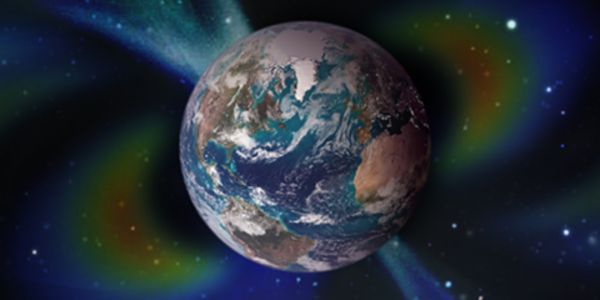Radio blackout occurred while hurricane crossed Caribbean
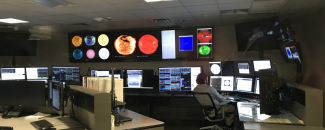
An unusually large solar flare erupted just as Hurricane Irma, with sustained winds of 185 mph, passed through the Caribbean. Scientists working with NCEI indicate the disturbance caused a radio blackout during the major weather emergency.
Around 12:00 UTC (8:00 a.m. local time in Puerto Rico) on September 6, a large X9 class X-ray flare erupted from the sun. Due to the unexpectedly large solar event, high frequency (HF) skywave radio communications were disrupted throughout the day as Hurricane Irma crossed the Caribbean at Category 5 strength. Several islands, among them St. Martin, Barbuda, the U.S. and British Virgin Islands, and Anguilla, sustained severe damages and casualties.
The hurricane and solar flare were coincidental but unrelated. The radio blackout affected the entire sunlit region of Earth.
Solar Flare Remarkable for Size, Effect
The flare on September 6 has been noted as the brightest and most powerful solar flare captured by satellite observing sensors in about a decade, and by a wide margin, it has been the most powerful of the recent solar cycle that began in December 2008. A subsequent large solar flare on September 10 was oriented away from Earth, so it was not considered as geo-effective to Earth as the flare during Irma. However, it also caused a radio blackout at the time Irma was rolling ashore in Florida.
As a result of the first flare, the Caribbean experienced conditions that essentially rendered HF skywave radio communication unusable for about eight hours during the day, which would have included aviation, maritime, HAM radio bands, and other HF emergency bands. A Geostationary Operational Environmental Satellite (GOES) plotted the solar event, and the data were captured by NOAA’s Space Weather Prediction Center.
Unlike states such as Texas, where Hurricane Harvey called upon the use of a wide range of communication systems prior to Irma, the solar event exposed the Caribbean’s communication vulnerabilities. Emergency services often rely on HF radio communications during extreme weather events.
“The islands of the Caribbean do not have as well-hardened a communication infrastructure as does Texas,” says Justin Mabie, who studies space weather phenomena with the Cooperative Institute for Research in Environmental Sciences (CIRES) with NCEI. “This makes emergency communications more susceptible to storm damage. Specifically, the reliance on HF communications to receive emergency information and to be able to transmit distress calls is more critical in this region.”
The Vertically Incident Pulsed Ionospheric Radar (VIPIR) located at Wallops Island, Virginia, continuously monitors the radio environment. A plot is obtained by transmitting radio waves over a range of frequencies and measuring the amount of power that is returned by the atmosphere. On a typical day, like September 5, daylight hours appear as a crescent moon shape, usually between 11:00 and 22:00 UTC.
The yellow and red colors in the signal to noise (SNR) plot represent frequencies that reflect well from the atmosphere and help identify optimal communication frequencies. The signal strength at 17:30 UTC experiences a “drop out” for about a half hour, shown on the plot above where the blue extends from the crescent to the upper frequencies, a response that’s more typical and briefer from a solar flare.
As Irma Struck
But by sunrise on September 6, as Hurricane Irma bore down on the Caribbean, the power plot changed dramatically, within minutes of the solar flare.
The intense weakening of the signal strength represents a nearly complete loss of HF communications that persisted throughout daylight hours. For comparison, the most powerful legal HF amateur radio transmitter produces 1500 watts of power. The data show the flare would have reduced a signal transmitted at 6 MHz to the equivalent of 5 watts, about as weak as a handheld radio.
During the blackout period, other forms of communication, such as AM radio towers or ground-to-ground communications, may have been able to send emergency broadcasts. The satellite and radio frequency data of the solar event are preliminary and will undergo further analysis and study.

